To my parents, Zeev and Corinne Bloom,
who respected my ability to choose and
taught me to do so wisely.
Copyright 2007 by Corwin Press.
First Skyhorse Publishing edition 2016.
All rights reserved. No part of this book may be reproduced in any manner without the express written consent of the publisher, except in the case of brief excerpts in critical reviews or articles. All inquiries should be addressed to Skyhorse Publishing, 307 West 36th Street, 11th Floor, New York, NY 10018.
Skyhorse Publishing books may be purchased in bulk at special discounts for sales promotion, corporate gifts, fund-raising, or educational purposes. Special editions can also be created to specifications. For details, contact the Special Sales Department, Skyhorse Publishing, 307 West 36th Street, 11th Floor, New York, NY 10018 or .
Skyhorse and Skyhorse Publishing are registered trademarks of Skyhorse Publishing, Inc., a Delaware corporation.
Visit our website at www.skyhorsepublishing.com.
10 9 8 7 6 5 4 3 2 1
Library of Congress Cataloging-in-Publication Data is available on file.
Cover design by Michael Dubowe
Print ISBN: 978-1-63450-369-3
Ebook ISBN: 978-1-5107-0127-4
Printed in the United States of America
Contents
Preface
T he poignant words of an 18-year-old boy inspired the writing of this book. In my second year of graduate school in social work, my field placement was with an agency that served chemically dependent adolescents. On the final day of my internship, that boy came up to me and said, Adina, Im so happy that I became addicted and that Im now in recovery because I came out so much better a person!
I was rendered speechless, dumbstruck by the riveting thought that what he received through the recovery process could have been his birthright. The knowledge and skills with which to develop positive, healthy, successful children and prevent future problems are available and teachable.
Armed with the words of that 18-year-old boy, a fervent belief in the potential of each individual to be fully actualized, a background in education, psychology, theater, and social work, and an unbridled desire to save the world, I chose to write this book. Teaching youngsters to make informed, effective choices regarding their emotional, physical, mental, and social well-being can lead to the development of happy, healthy, high-functioning adults.
Teaching Emotional Intelligence will do just that. This is not a pipe dream, nor is this a book of gimmicks and catchphrases. It is a curriculum based on the understanding that students think and behave ineffectively because they lack the skills and information with which to make more effective cognitive and behavioral choices. This curriculum provides teachers with the tools to transmit those important skills and that vital body of information.
As more and more children grow into adults who feel good about themselves, manage their emotions effectively, communicate clearly, learn how to resolve conflicts, and how to meet their needs in positive ways, we can move as a society toward the development of a healthy, high- functioning civilization. At the very least, we will end up with healthier, higher functioning classrooms and happier students and teachers.
I am very grateful to for the opportunity to publish a comprehensive, user-friendly edition of this book. Teaching Emotional Intelligence reflects an understanding that the curriculum is most effective for use in second through sixth grades and secondarily in seventh and eight grades. Modifications are provided for these last two grades. The chapter and section headings have been reorganized for greater clarity. The introduction has been greatly expanded to reflect current research as well as to clarify the theoretical framework of the lessons. A session on bullying has been added as well as an epilogue to offer the reader some examples of success stories from using the lessons.
The scenes in each section have been rewritten to enhance understanding of the process of assumptions influencing thoughts, affecting emotions, and leading to actions and to simplify the enactment of the scenes. In addition, following each scene, a series of questions with accompanying answers have been provided for a more in-depth analysis of the scene. Also, certain sections have additional suggested activities.
 ACKNOWLEDGMENTS
ACKNOWLEDGMENTS
I would like to thank those educators who share my vision and will attempt to bring it to fruition, one child at a time. I would also like to thank SkyLight for the initial opportunity to try to leave the world a better place than I found it. In particular, I would like to thank Jean Ward, who was the first to share my vision, Sue Schumer, and Dara Lee Howard, who edited the manuscript.
I would like to thank Cathy Hernandez at Corwin Press for allowing the vision to continue and for her patience with my revision process. I would also like to thank Astrid Virding, production editor, and Jacqueline Tasch, copy editor, for their help in getting my book ready for publication.
I thank my children, Ellis and Zanna, for putting up with all the hours devoid of Eensy, Weensy Spider and with all the mom-free games of Trouble. I thank my husband, Zvi, for all the hours he had to sing The Wheels on the Bus and mediate sibling spats, for all the years of supporting me while I wrote this edition of this book, and for all the hugs and reassurances throughout the process. I give thanks to my mother for being my secretary/wife, nanny/friend. I thank my mentors, Zeev Bloom, Ken Simpson, Howard Goldstein, and Mitchell Fields, for their inspiration. And I thank an 18-year-old boy for giving me the final impetus to write Teaching Emotional Intelligence.
 PUBLISHERS ACKNOWLEDGMENTS
PUBLISHERS ACKNOWLEDGMENTS
Skyhorse Publishing gratefully acknowledges the contributions of the following reviewers:
Sherri Becker
Eighth grade English teacher
Mitchell Middle School
Mitchell, South Dakota
Jennifer Betters
School counselor
Sugar Creek Elementary School
Verona, Wisconsin
Cheri DiMartino
Gifted and talented specialist
Eva Wolfe Elementary School
North Las Vegas, Nevada
Jane Hampton
Principal
Oak Mountain Elementary School
Birmingham, Alabama
Deborah Hardy
Guidance and counseling chair
Irvington High School
Irvington, New York
Elizabeth B. Lengle
School counselor
Warrior Run School District
Turbotville, Pennsylvania
Greg OConnell
Assistant principal
Grant Wood Elementary School
Cedar Rapids, Iowa
Diane Smith
School counselor
Smethport Area School District
Smethport, Pennsylvania
About the Author
 Adina Bloom Lewkowicz, L.I.S.W., is a prevention specialist, curriculum consultant, therapist, actress, and mother of twins. Most recently, she was the coordinator of the SAY (Social Advocates for Youth) Coalition of Bellefaire JCB in Cleveland, Ohio, providing prevention programs and materials for adolescents. Adina has had extensive experience as an expressive arts therapist, working with individuals ranging in age from toddlers through senior adults. Adina speaks and consults nationally on teaching emotional intelligence, as well as on using expressive arts in education, prevention, and therapy. Adina developed a curriculum for an afterschool day care program using the expressive arts to complement the standard school curriculum. As artist-in-residence with the Ohio Arts Council/National Endowment for the Arts Artist-in-Education program, Adina traveled throughout the state of Ohio, providing in-school drama residencies for youngsters of all ages. In addition, Adina has performed as an actress and singer throughout the East Coast in summer stock and dinner and regional theaters.
Adina Bloom Lewkowicz, L.I.S.W., is a prevention specialist, curriculum consultant, therapist, actress, and mother of twins. Most recently, she was the coordinator of the SAY (Social Advocates for Youth) Coalition of Bellefaire JCB in Cleveland, Ohio, providing prevention programs and materials for adolescents. Adina has had extensive experience as an expressive arts therapist, working with individuals ranging in age from toddlers through senior adults. Adina speaks and consults nationally on teaching emotional intelligence, as well as on using expressive arts in education, prevention, and therapy. Adina developed a curriculum for an afterschool day care program using the expressive arts to complement the standard school curriculum. As artist-in-residence with the Ohio Arts Council/National Endowment for the Arts Artist-in-Education program, Adina traveled throughout the state of Ohio, providing in-school drama residencies for youngsters of all ages. In addition, Adina has performed as an actress and singer throughout the East Coast in summer stock and dinner and regional theaters.

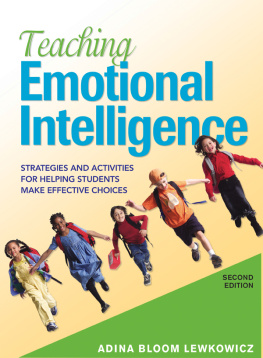


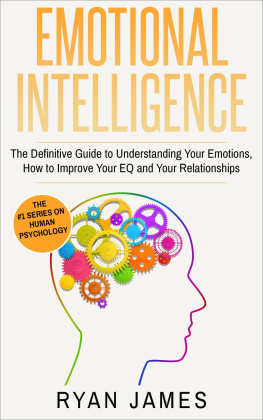
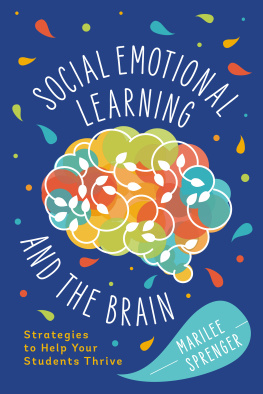
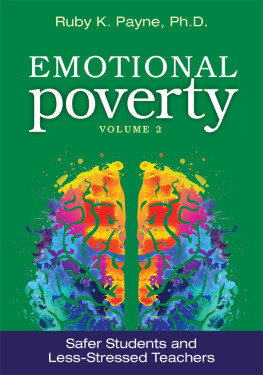
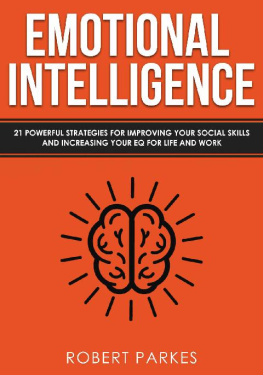


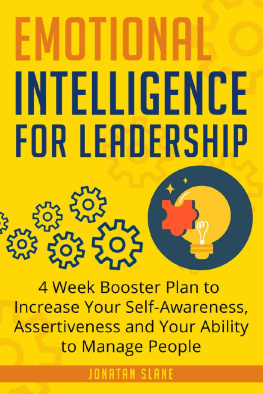
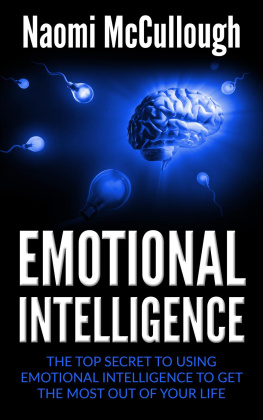


 ACKNOWLEDGMENTS
ACKNOWLEDGMENTS Adina Bloom Lewkowicz, L.I.S.W., is a prevention specialist, curriculum consultant, therapist, actress, and mother of twins. Most recently, she was the coordinator of the SAY (Social Advocates for Youth) Coalition of Bellefaire JCB in Cleveland, Ohio, providing prevention programs and materials for adolescents. Adina has had extensive experience as an expressive arts therapist, working with individuals ranging in age from toddlers through senior adults. Adina speaks and consults nationally on teaching emotional intelligence, as well as on using expressive arts in education, prevention, and therapy. Adina developed a curriculum for an afterschool day care program using the expressive arts to complement the standard school curriculum. As artist-in-residence with the Ohio Arts Council/National Endowment for the Arts Artist-in-Education program, Adina traveled throughout the state of Ohio, providing in-school drama residencies for youngsters of all ages. In addition, Adina has performed as an actress and singer throughout the East Coast in summer stock and dinner and regional theaters.
Adina Bloom Lewkowicz, L.I.S.W., is a prevention specialist, curriculum consultant, therapist, actress, and mother of twins. Most recently, she was the coordinator of the SAY (Social Advocates for Youth) Coalition of Bellefaire JCB in Cleveland, Ohio, providing prevention programs and materials for adolescents. Adina has had extensive experience as an expressive arts therapist, working with individuals ranging in age from toddlers through senior adults. Adina speaks and consults nationally on teaching emotional intelligence, as well as on using expressive arts in education, prevention, and therapy. Adina developed a curriculum for an afterschool day care program using the expressive arts to complement the standard school curriculum. As artist-in-residence with the Ohio Arts Council/National Endowment for the Arts Artist-in-Education program, Adina traveled throughout the state of Ohio, providing in-school drama residencies for youngsters of all ages. In addition, Adina has performed as an actress and singer throughout the East Coast in summer stock and dinner and regional theaters.